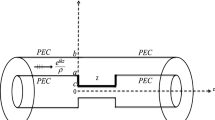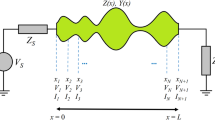Abstract
Various excitations of a new groove guide resonator working in the X-band (8 GHz – 12 GHz) are investigated by means of numerical simulations. For the numerical simulations the Finite-Difference Time-Domain method is used. The groove guide resonator, modelled both with and without excitation structures, is discretised in space. The results in the time domain are then transformed into the frequency domain in order to obtain the resonance frequency spectrum. Comparison between simulations with and without excitations shows the effect of the excitations on the resonance frequency spectrum. The results are compared with those of previous analytical methods.
Similar content being viewed by others
References
[1] Tischer J.F., “The Groove Guide, a Low Loss Waveguide for Millimeter Waves”, IEEE Trans. on Microwave Theory and Techniques, Sept. 1963, pp. 291–296.
[2] Chi H., “Analyzing Semicircular Groove Guide With The Conformal Mapping Technique”, International Journal of Infrared and Millimeter Waves, Vol. 24, No. 11, Nov. 2003, pp. 1999–2006.
[3] Nakahara T., Kurauchi N., “Transmission Modes in the Grooved Guide”, Sumitomo Electric Technical Review, No: 5, Jan. 1965, pp. 65–71.
[4] Choi Y.M., Harris D.J., Tsang K.F., “Theoretical and Experimental Characteristics of Single V-Groove Guide for X-Band and 100 GHz Operation”, IEEE Trans. on Microwave Theory and Techniques, April 1963, pp. 715–723.
[5] Sachidananda I.M., “Rigorous Analysis of a Groove Guide”, IEE Proceedings-H, Vol. 139, No. 5, Oct. 1992, pp. 449–452.
[6] Ma Z., Yamashita E., Xu S., “Modal Analysis of Open Groove Guide with Arbitrary Groove Profile”, IEEE Microwave and Guided Wave Letters, Vol. 2, No. 9, Sept. 1992, pp. 364–366.
[7] Yang H.-S., Ma J., Lu Z.-Z., “Circular Groove Guide for Short Millimeter and Submillimeter Waves”, IEEE Trans. on Microwave Theory and Techniques, Vol. 43, No. 2, Feb. 1995, pp. 324–330.
[8] Oliner A.A., Lampariello P., “The Dominant Mode Properties of Open Groove Guide: An Improved Solution”, IEEE Trans. on Microwave Theory and Techniques, Sept. 1985, pp. 755–763.
[9] Fernyhough M., Evans D.V., “Full Multimodal Analysis of an Open Rectangular Groove Waveguide”, IEEE Trans. on Microwave Theory and Techniques, Vol. 46, No. 1, Jan. 1998, pp. 97–107.
[10] Tsang K.F., Shi W.M., “Analysis of rectangular-groove Guide by Using the Method of Lines”, Proceedings, 4th International Conference on Millimeter Wave and Far Infrared Science and Technology, 1996, pp. 103–106.
[11] Lu M., Yang Z., Wei F.-L., “On The Main Mode Of Trapezoidal-Groove Guide by Finite Element Method”, International Journal of Infrared and Millimeter Waves, Vol. 19, No. 3, 1998, pp. 529–541.
[12] Aydinlik Bechteler A.S., Sevgi L., “Millimeter Waveband SemiSymmetrical Groove Guide Resonators”, IEEE Microwave Magazine, Sept. 2004, pp. 51–60.
[13] Griemsmann J.W.E., “The Groove Guide”, The Symposium on Quasi-Optics, Polytechnic Institute Brooklyn, June 1964, pp. 565–578.
[14] Liu Y., Yang H.-S., “Wide-Band Circular Groove Guide Horn Antenna”, IEEE Trans. on Antennas and Propagation, Vol. 51, No. 3, March 2003, pp. 395–398.
[15] Vertiy A.A., Gavrilov S.P., Aydinlik S., Samedov S., “Circular Groove Shaped Resonator for Millimeter Waves”, International Journal of Infrared and Millimeter Waves, Vol. 17, No. 10, 1996, pp. 1613–1637.
[16] Taflove A., “Computational Electrodynamics - The Finite-Difference Time-Domain Method”. Artech House, Norwood, 1995.
Author information
Authors and Affiliations
Rights and permissions
About this article
Cite this article
Bechteler, T. Analysis of Excitations for a Groove Guide Resonator at 10 GHz by means of the FDTD Method. Int J Infrared Milli Waves 26, 819–830 (2005). https://doi.org/10.1007/s10762-005-5654-5
Received:
Published:
Issue Date:
DOI: https://doi.org/10.1007/s10762-005-5654-5




